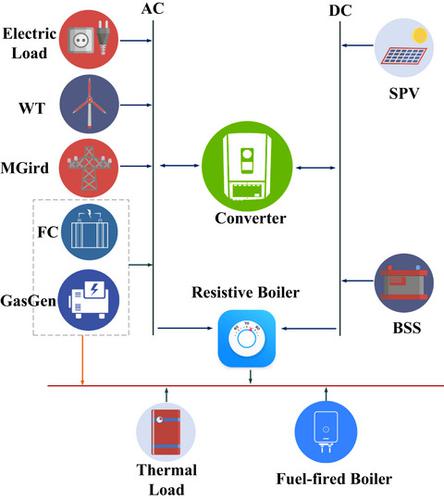当前位置:
X-MOL 学术
›
Energy Sci. Eng.
›
论文详情
Our official English website, www.x-mol.net, welcomes your
feedback! (Note: you will need to create a separate account there.)
Techno-economic optimization of a grid-connected hybrid energy system considering electric and thermal load prediction
Energy Science & Engineering ( IF 3.5 ) Pub Date : 2021-05-12 , DOI: 10.1002/ese3.906 Ting Qiu 1 , Jamal Faraji 2
Energy Science & Engineering ( IF 3.5 ) Pub Date : 2021-05-12 , DOI: 10.1002/ese3.906 Ting Qiu 1 , Jamal Faraji 2
Affiliation

|
Optimal planning of hybrid energy systems has always been a considerable task. While several studies have conducted techno-economic analysis on hybrid energy systems, most of them have neglected to consider appropriate electric and thermal load growth rates. This paper proposes an efficient strategy for optimizing a grid-connected hybrid energy system considering electric and thermal load growth rates. HOMER software is used for optimizing hybrid energy systems. It uses a nonderivative optimization to recognize the system with the minimum net present cost (NPC) among hundreds of configurations. The exponential smoothing method is also used for predicting upcoming load peak values based on historical data. The proposed hybrid system includes solar photovoltaic (SPV) system, wind turbine (WT) system, converter, battery storage system (BSS), gas generator (GasGen), fuel cell (FC), fuel-fired boiler, and resistive boiler. Unlike previous studies, electricity price growth and SPV degradation rates are considered in this study. The grid-connected system has also been compared to the stand-alone system to understand grid connection impacts on the optimization results. Environmental analysis has been performed to analyze the greenhouse gas emissions of each system. The effects of growth rates in thermal and electric loads and electricity price are comprehensively investigated. Neglecting load growth rates affected the financial results severely. In this condition, the NPC and COE are achieved −11 383.4 US$ and −0.02376 US$/kWh. Results indicate that the combination of WT system (15 kW), converter (10 kW), resistive, and fuel-fired (10 kW) boilers is the most economical configuration in grid-connected mode. The WT system plays an essential role in the electric power provision and revenues of the hybrid system. The net present cost (NPC) and the cost of energy (COE) for grid-connected operating mode are achieved −0.0162272 US$/kWh and −5243.956 US$, respectively. For off-grid operating mode, the NPC and COE are obtained 47 024.19 US$ and 0.1983879 US$/kWh, respectively. Thanks to the feed-in-tariff (FiT) policy, the proposed grid-connected system is more economical and environmentally friendly than the stand-alone system. In off-grid operating mode, 63 575.45285 kg CO2 is produced, which is higher than CO2 production in the grid-connected mode (more than 8262 kg).
中文翻译:

考虑电热负荷预测的并网混合能源系统技术经济优化
混合能源系统的优化规划一直是一项艰巨的任务。虽然一些研究对混合能源系统进行了技术经济分析,但其中大多数都忽略了适当的电力和热负荷增长率。本文提出了一种考虑电力和热负荷增长率的优化并网混合能源系统的有效策略。HOMER 软件用于优化混合能源系统。它使用非导数优化来识别数百种配置中具有最小净现值 (NPC) 的系统。指数平滑方法还用于根据历史数据预测即将到来的负载峰值。拟议的混合系统包括太阳能光伏(SPV)系统、风力涡轮机(WT)系统、转换器、电池存储系统(BSS)、燃气发生器 (GasGen)、燃料电池 (FC)、燃料锅炉和电阻锅炉。与之前的研究不同,本研究考虑了电价增长和 SPV 退化率。并网系统还与独立系统进行了比较,以了解并网系统对优化结果的影响。已执行环境分析以分析每个系统的温室气体排放。综合研究了热负荷和电力负荷增长率以及电价的影响。忽视负荷增长率严重影响了财务业绩。在这种情况下,NPC 和 COE 达到 -11 383.4 US$ 和 -0.02376 US$/kWh。结果表明,WT 系统 (15 kW)、转换器 (10 kW)、电阻、和燃油 (10 kW) 锅炉是并网模式中最经济的配置。WT 系统在混合动力系统的电力供应和收入中起着至关重要的作用。并网运行模式的净现值 (NPC) 和能源成本 (COE) 分别达到 -0.0162272 美元/千瓦时和 -5243.956 美元。对于离网运行模式,NPC 和 COE 分别为 47 024.19 美元和 0.1983879 美元/千瓦时。由于上网电价(FiT)政策,拟议的并网系统比独立系统更经济和环保。在离网运行模式下,63 575.45285 kg CO 并网运行模式的净现值 (NPC) 和能源成本 (COE) 分别达到 -0.0162272 美元/千瓦时和 -5243.956 美元。对于离网运行模式,NPC 和 COE 分别为 47 024.19 美元和 0.1983879 美元/千瓦时。由于上网电价(FiT)政策,拟议的并网系统比独立系统更经济和环保。在离网运行模式下,63 575.45285 kg CO 并网运行模式的净现值 (NPC) 和能源成本 (COE) 分别达到 -0.0162272 美元/千瓦时和 -5243.956 美元。对于离网运行模式,NPC 和 COE 分别为 47 024.19 美元和 0.1983879 美元/千瓦时。由于上网电价 (FiT) 政策,拟议的并网系统比独立系统更经济和环保。在离网运行模式下,63 575.45285 kg CO2,高于并网模式下的CO 2产量(超过8262 kg)。
更新日期:2021-05-12
中文翻译:

考虑电热负荷预测的并网混合能源系统技术经济优化
混合能源系统的优化规划一直是一项艰巨的任务。虽然一些研究对混合能源系统进行了技术经济分析,但其中大多数都忽略了适当的电力和热负荷增长率。本文提出了一种考虑电力和热负荷增长率的优化并网混合能源系统的有效策略。HOMER 软件用于优化混合能源系统。它使用非导数优化来识别数百种配置中具有最小净现值 (NPC) 的系统。指数平滑方法还用于根据历史数据预测即将到来的负载峰值。拟议的混合系统包括太阳能光伏(SPV)系统、风力涡轮机(WT)系统、转换器、电池存储系统(BSS)、燃气发生器 (GasGen)、燃料电池 (FC)、燃料锅炉和电阻锅炉。与之前的研究不同,本研究考虑了电价增长和 SPV 退化率。并网系统还与独立系统进行了比较,以了解并网系统对优化结果的影响。已执行环境分析以分析每个系统的温室气体排放。综合研究了热负荷和电力负荷增长率以及电价的影响。忽视负荷增长率严重影响了财务业绩。在这种情况下,NPC 和 COE 达到 -11 383.4 US$ 和 -0.02376 US$/kWh。结果表明,WT 系统 (15 kW)、转换器 (10 kW)、电阻、和燃油 (10 kW) 锅炉是并网模式中最经济的配置。WT 系统在混合动力系统的电力供应和收入中起着至关重要的作用。并网运行模式的净现值 (NPC) 和能源成本 (COE) 分别达到 -0.0162272 美元/千瓦时和 -5243.956 美元。对于离网运行模式,NPC 和 COE 分别为 47 024.19 美元和 0.1983879 美元/千瓦时。由于上网电价(FiT)政策,拟议的并网系统比独立系统更经济和环保。在离网运行模式下,63 575.45285 kg CO 并网运行模式的净现值 (NPC) 和能源成本 (COE) 分别达到 -0.0162272 美元/千瓦时和 -5243.956 美元。对于离网运行模式,NPC 和 COE 分别为 47 024.19 美元和 0.1983879 美元/千瓦时。由于上网电价(FiT)政策,拟议的并网系统比独立系统更经济和环保。在离网运行模式下,63 575.45285 kg CO 并网运行模式的净现值 (NPC) 和能源成本 (COE) 分别达到 -0.0162272 美元/千瓦时和 -5243.956 美元。对于离网运行模式,NPC 和 COE 分别为 47 024.19 美元和 0.1983879 美元/千瓦时。由于上网电价 (FiT) 政策,拟议的并网系统比独立系统更经济和环保。在离网运行模式下,63 575.45285 kg CO2,高于并网模式下的CO 2产量(超过8262 kg)。











































 京公网安备 11010802027423号
京公网安备 11010802027423号